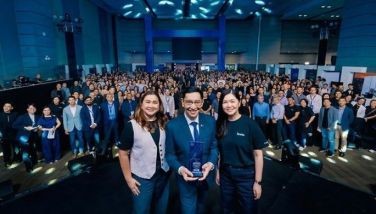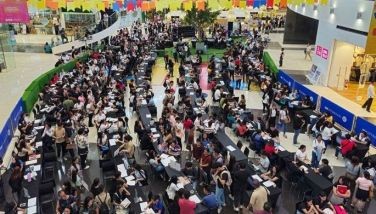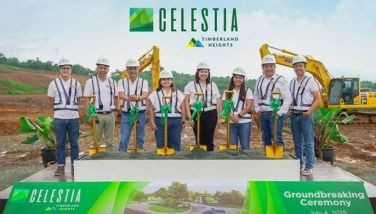Takakura way of composting for a greener life
CEBU, Philippines - Who would not want to be in a place where people live peacefully and safely in harmony with nature? Where people inhale clean air, drink clean water, walk safely along the roads, and where people are truly mindful of their impact on the environment. Well, a green city is the place to be!
There could be a lot of possible ways on how to attain a green city and we are always part of this drive. If we look around our surroundings, we can see many beautiful creations and we are responsible for the preservation of their beauties.
“Today, the environment is one of the world’s biggest concerns. We are constantly reminded to recycle, to dispose our wastes properly, and to preserve our environment in countless other ways†said Ma. Lourdes Onozawa, an environmentalist architect who dedicatedly takes this advocacy to heart.
Onozawa had already taken part in stabilizing the beauty of nature through applying her knowledge about environmentally friendly practices in planning, design, building and maintenance of homes, communities, and hospitality structures in her own field which is architecture.
Just like her, we can also do our share. We might be in different fields of work but still we are tangled in one responsibility; to preserve the beauty of nature.
We are at all times reminded to help and we could help through means of reducing (the process of transposing a product to a new one), reusing (the process of reprocessing a material and using the product in a different way), recycling (the process of transforming waste materials into new products) and composting (the process of decomposing and recycling the organic matter to be used as a fertilizer and soil amendment), etc.
The 3r’s of the environment is basically not new for everybody but this composting method is kind of strange for some people so there has been this composting method introduced to us to solve the waste problem in Asian countries and this method is called the “Takakura Home Method†or “Takakura Methodâ€.
The Takakura method uses native organisms for composting – cultured and fermented from locally available materials such as fresh fruits, vegetable peels, coconut wine, brown sugar, rice bran and rice husks.
This method is practiced by households in urban areas and can also be applied for composting market wastes in larger areas.
It was developed by Mr. Koji Takakura from the Japanese JPEC Company, in partnership with the Kitakyushu Initiative Network (KIN) of the United Nations Economic and Social Commission for Asia and the Pacific (UNESCAP) and Surabaya, Indonesia City as well as Kitakyushu International Techno-Cooperative Association (KITA) in Kitakyushu City, Japan.
It first operated in Japan and Surabaya, Indonesia was the first city outside Japan to use it. In the Philippines, Bago City in Negros Occidental was the first city to utilize the method in 2008 and was applied in Cebu in the same year. Now, Thailand, Malaysia and other 20 countries are also using the method.
In the case of Cebu City, the city government distributed chemical fertilizers to agriculturists in mountain barangays but as its price soared, they realized that there could be an alternative to it. They then purchased the compost from the Japanese distributors and distributed it free of charge to encourage the switch to the Takakura compost method.
“I did this to not only solve the problem of protecting the ecosystems, but I think it was actually a necessary process to spread the method to the local people.†Mr. Takakura stated in one of his interviews.
The method was introduced to some barangays and since then, the city government received good feedback from some households and universities that have made use of the method like St. Theresa’s College – Cebu and Southwestern University.
Barangays in Cebu city that have already adopted the method are Barangays Punta Princesa, Inayawan, Quiot, T. Padilla, Capitol Site, Ermita, Guadalupe, Labangon, Sambag, Tisa, Tag Bao, Mambaling, Luz, Carreta, Capitol Site, Kamputhaw, Mabolo, Tinago and Sawang Calero as well as the Cebu Environmental Sanitation Enforcement Team (CESET). (Source: Cebu City. Compiled by Premakumara, 2010/2011)
The Takakura Home Method is easy, fast, cheap, sanitary, odorless, and makes good quality compost. These make it different and more effective than those of other compost technology methods.
“Wala na’y mag lupad-lupad nga uk-ok sa among balay tungod sa Takakura,†said Ruby Tejano, a first year Accountancy student of St. Theresa’s College shared.
“Sukad gi-require mi’g buhat og takakura sa among maestro sa NSTP, puros nalang biodegradable nga basura ang mahabilin sa among balay†she added.
With the continuous support the government has been giving the said method, it has now extended and some entrepreneurs had brought it to business. A ready-to-use Takakura Composting was introduced to people and a happy customer shared her experience with it.
“I was just so happy to discover this composting method. I’d been trying at home to make use of our fruits and vegetable scraps by trying to make our own composting but they went all nil as they got so stinky, and I don’t know how to do a better job of it†the customer said.
As a result, people tend to think the Takakura Home Method is easy to apply, like “Oh, we can do this by ourselves†and indeed it is. All materials needed to apply this method can be found within the four walls of your houses.
Things needed for composting: rice husk, rice bran, fermented foods (such as Lactopafi, Tuba coconut wine, dry yeast), vegetables/fruits, (kitchen scraps) mushroom, sugar, salt, basket, sack, and a cloth.
The last step is on using the compost which gradually releases nutrients into the soil, thereby improving the soil environment.
Takakura Home Method of Composting can help reduce organic waste generation and global warming. It is a fast, easy and economic method which leads to hygienic improvements to our living environment, elimination of foul odors and emission of methane gas.
It has always been and will always be about people’s livability standards and a green life for a green city is the perfect approach for a better life. So let’s start living a better green life by Reducing, Reusing, Recyling, Composting! - /ATO (FREEMAN)
- Latest



















